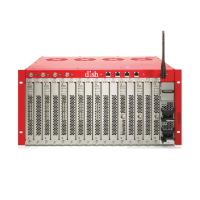30
CHAPTER 9 ATSC INSTALLATION
Preface
The SMARTBOX ATSC blade is designed to receive eight (8) local (o-air) digital ATSC channels per blade and
distribute them throughout the property.
Receiving o-the-air digital TV stations is not as simple as putting up a TV antenna and hoping for the best. This
Chapter provides an overview of the required pre-installation planning processes, receive RF equipment selection,
installation process as well as the configuring and operating of your SMARTBOX unit and ATSC blade.
The following sections provide high-level guidance for receiving the desired ATSC services via SMARTBOX.
These sections are not comprehensive and not intended to instruct you on how to successfully install the
antenna. The in-depth details of these topics are presented in the SMARTBOX ATSC Best Practices document
that is available on the DISH Portal. Without reviewing, understanding, and applying the presented Best Practices
information, success in receiving all of the desired ATSC services at your customer’s sites are not likely to be
realized.
ATSC Input Signal Characteristics
RF signals received by the ATSC blade are measured by signal power and signal quality.
Signal power is typically measured in dBmV (or dBm).
Signal quality is typically measured as the signal-to-noise ratio (SNR) or the modulation error ratio (MER), both
of which are measured in dB. The SMARTBOX ATSC blade measures SNR and also maintains a count of Reed
Solomon Errors (shown as RS Uncorrected).
When tuning the antenna for best signal reception, signal quality (SNR) should always be considered more
important than signal strength (RSSI). The below table provides general guidelines on signal measurements and
how they correspond to acceptable performance (e.g., “poor” is not acceptable).
Signal Quality and Signal Level Measurements for ATSC Blade
Parameter Measurement Value Status Comment
SNR (dB)
(Signal to Noise Ratio)
> 22 Excellent Signal quality measurement (Note:
when SNR < 18 (Poor) there is a high
likelihood that uncorrected channel
errors are occuring and that video
quality suers (e.g., pixilation)
20-22 Good
18-20 Acceptable
<18 Poor
18 (Low Bad)
RSSI (dBm/dBmV)
> -35 / +13.8 Excellent
Signal power (dBm) and
level (dBmV) measurement
-36 to -50 / +12.8 to -1.3 Good
-50 to -75 / -1.3 to -26.3 Acceptable
-75 and lower+ / -26.3 to -36.3+ Poor
-80 / -31.3 (Low Bad)

